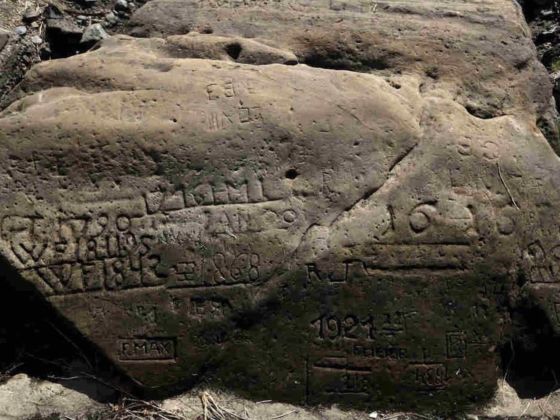An old harbinger of grim news has resurfaced again in the Czech Republic, warning of tough times ahead. In the middle of the Elbe River, a “hunger stone” has just become visible again due to the lowering of the water level. Inscribed by a boatman in 1904 with the words, “Wenn du mich siehst, dann weine” — if you can see me, then weep — the stone is meant to warn against falling water levels and drought. The stone is one of 20 similar boulders in the Elbe dating back to 1616, originally marked by men whose trade and livelihood depended on the river.


Centuries Old “Hunger Stones” Emerge in Czech Republic With Dire Carved Warnings
Vlastimil Pazourek, head of the museum in Decin, where the stone appeared, told AFP, “Over the centuries, many people earned their living on the Elbe as rafters, and when there wasn’t enough water to float their rafts, they lost their livelihoods… the rafters engraved the dates of those bad years on the soft sandstone boulders.”
View this post on Instagram
A post shared by Jason Beatty (@miseryistheriveroftheworld) on
Scientists, however, believe that 2018 isn’t just another bad year, but that the stone’s exposure is a sign of climate change. The “hunger stone” was revealed this year after one of the hottest summers on record, during which the Elbe’s water level dropped to just 2.9 feet deep. The river has been an important highway for commerce, with five million tons of goods being transported along the Elbe in the 1990s, but that number has fallen drastically in recent years. And this year, the low water levels have made large-scale river transport impossible.
True to its name, the “hunger stone” seems to have predicted a tough harvest — not just in the Czech Republic but also in Germany, the UK, and other countries in Western Europe. Last year, around 94 percent of Czech farmers reported severe crop damage, and Udo Hemmerling, Deputy Secretary General of the German Farmers Association, told Euronews, “This year we have the lowest harvest of the century.”
And it’s not only drought stones that are resurfacing with the drying of rivers. This year alone, 22 grenades, mines, and other explosives have been found in the Elbe.
If you’re looking for one silver lining to climate-change-induced draught, you’ll find it in wine country. “Less rain, more sun, warmer temperatures, less frost,” are good for the grape harvest, said Vincent Chaperon, a cellar master at Dom Perignon Champagne in France. So if the rivers all dry up and all the crops disappear, at least we’ll have enough wine.
H/T: Second Nexus